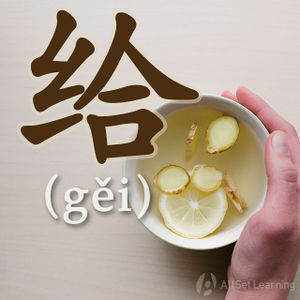Expressing "for" with "gei"
-
Level
-
Similar to
-
Used for
-
Keywords
The preposition 给 (gěi) can mean "for," as in, "everything I do, I do it for you." You can also think of it to mean "give," like to give a service or to give an Obj.. In this case, the default position of the character is before the verb, although it sometimes comes after, depending on the verb.
Contents
Basic Usage
The meaning of 给 is very similar to 为 (wèi) in Chinese, but 给 is more informal than 为, and there are many cases where it's simply based on convention and general practice to decide to use one or the other.
Structure
Subj. + 给 + [Recipient] + Verb + Obj.
Note that the "recipient" in the pattern above is usually a person, but isn't necessarily a person. It could be an animal, or company, or any number of other types of recipients.
Examples
- 我 要 给 孩子 们 做饭 。 I need to cook for the kids.
- 我 给 你 当 翻译 。 I'll serve as translator for you.
- 你的 父母 会 不 会 给 你 买 房子 ? Will your parents buy a home for you?
- 你 给 我 泡 一 杯 茶 好 吗 ? Could you make a cup of tea for me?
- 老公 给 我 买 了 一 个 大 蛋糕。 My husband bought a big cake for me.
- 我 给 你 削 个 苹果 吃。 I'll peel an apple for you.
- 看,我 给 你 带 了 什么? Look what I brought for you.
- 可以 给 我 送 到 门口 吗?Could you send it to the door for me?
- 小时候,妈妈 经常 给 我 讲 故事。 In some cases, translating with "for" in English doesn't work well.When I was little, mom often told me stories.
- 医生 在 给 病人 看 病。 In some cases, translating with "for" in English doesn't work well.The doctor is seeing the patient.
- 这 个 阿姨 给 你 检查 身体。 This would be a health check scenario.This lady will examine your body.
Usage After the Verb
There are some common verbs which allow the 给 to follow the verb. For more on this usage, please see the article "gei" following verbs.
Structure
Subj. + Verb + 给 + [Recipient] + Obj.
Examples
For examples of this usage, please see the article "gei" following verbs.
See also
Sources and further reading
Books
Dictionaries
- 现代汉语词典(第5版) (p. 464) →buy



